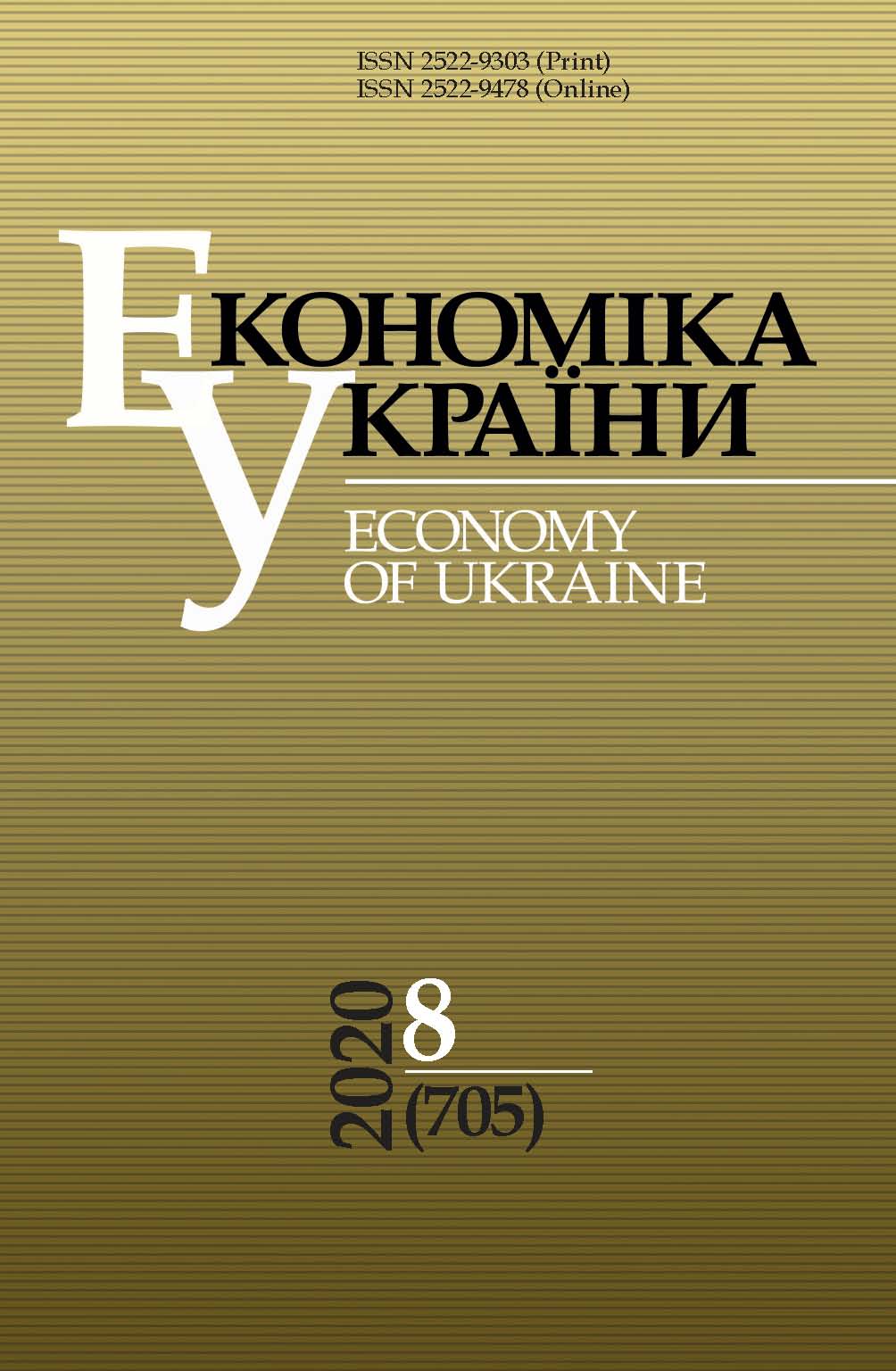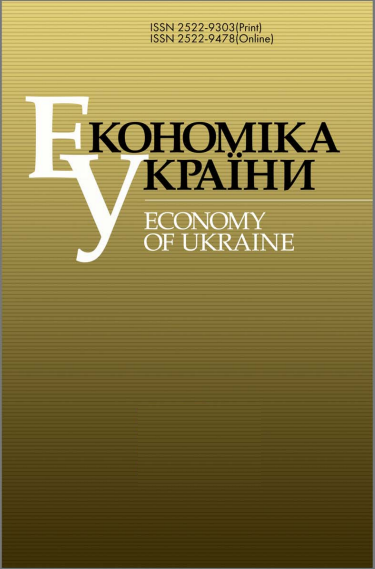THE RATIO OF THE DYNAMICS OF LABOR PRODUCTIVITY AND CAPITAL-LABOR RATIO AS AN INDICATOR OF OPTIMAL COORDINATION OF FIXED ASSETS AND THE NUMBER OF STAFF AT AN ENTERPRISE
DOI:
https://doi.org/10.15407/economyukr.2020.08.040Keywords:
labor productivity; capital-labor ratio; return on assets; advance coefficient; revaluation of fixed assetsAbstract
Theoretically possible options for combining the dynamics of interrelated indicators of labor productivity, capital-labor ratio and return on assets at an enterprise are discussed. The positive and negative growth of capital-labor ratio from the point of view of its correlation with increase of labor productivity is studied. It is proved that the increase of capital-labor ratio can be considered as positive only in combination with an increase in return on assets. All other variants of growth (decrease) of capital-labor ratio should be considered as a negative phenomenon in the economy of an enterprise, industry or region.
The negative increase of capital-labor ratio in the industry of Ukraine in 2010–2018 is analyzed. During the studied period, the return on capital varied unstably, showing an erratic downward trend, and the relative rate of increase of capital-labor ratio of industry was 1.13 times faster than the same indicator of labor productivity dynamics. Thus, there was a non-optimal trend in the dynamics of capital-labor ratio in the industry of Ukraine in 2010–2018: its increase left behind the growth of labor productivity with a corresponding deterioration in the use of fixed assets.
The obtained conclusion is confirmed by modeling of the dynamics of sales, residual value of fixed assets and the average number of employees in the industry of Ukraine using the production function of Cobb-Douglas-Tinbergen. Another number of practical results are obtained according to the dynamics of economic activity of domestic enterprises of food industry and mechanical engineering. Models built on the basis of various production functions (all, without exception) show non-optimal capital-labor ratio due to the excessive value of the average annual value of fixed assets compared with the number of staff. It turned out that among the causes of this economic phenomenon the main one is the constantly growing fictitious surplus of fixed assets of enterprises, formed as a result of their overestimation, because, unlike the number of employees, fixed assets in the numerator of capital-labor ratio are expressed in cost units heavily influenced by inflation rate in the country.
References
Ivashchenko V., Bolyukh M. Economic Analysis of Business Activity. Kyiv, JSC "NICHLAVA", 2001 [in Ukrainian].
Yankovyi O., Yankovyi V. Capital-labor ratio in Ukraine's machine building: reality and optimality. Economy of Ukraine, No. 8 (681), 2018, pp. 16-29 (doi.org/10.15407/economyukr.2018.08.016) [in Ukrainian].
doi.org/10.15407/economyukr.2018.08.016
Enterprise Finance. A.M. Podderogin (Ed.). Kyiv, KNEU, 2000 [in Ukrainian].
Yurchyshena L., Volynets S. An analysis of efficiency of the use of the fixed assets is on enterprise. Efektyvna ekonomika, No. 8, 2011, available at: www.economy.nayka.com.ua/?op=1&z=668 [in Ukrainian].
Kulko I. Assessment and analysis of the basic production assets of enterprises. State and Regions. Series: Social Communications, No. 3, 2013, pp. 166-169 [in Ukrainian].
Pindyck P., Rubinfeld D. Microeconomics. Saint Petersburg, Piter, 2002 [in Russian].
Microeconomics. Saint Petersburg, Institute "Economic School", 2004, available at: microeconomica.economicus.ru/index1.php?file=8_1 [in Russian].
Galperin V., Ignatiev S., Morgunov V. Microeconomics. Saint Petersburg, Institute "Economic School", 2004 [in Russian].
Yankovyi V. Forecasting the break-even zone of investments in the bakery industry using the production function. Socio-Economic Research Bulletin, No. 22, 2006, pp. 410-414 [in Ukrainian].
Cherevko Ye. Optimal capital adequacy and initial capital. Socio-Economic Research Bulletin, No. 26, 2007, pp. 359-365 [in Ukrainian].
Daniels G., Kakar V. Economic Growth and the CES Production Function with Human Capital. Economics Bulletin, Vol. 37, Iss. 2, 2017, pp. 930-951, available at: ssrn.com/abstract=2878578 or dx.doi.org/10.2139/ssrn.2878578.
doi.org/10.2139/ssrn.2878578
Alvarez-Cuadrado F., van Long N., Poschke M. Capital-labor substitution, structural change, and growth. Theoretical Economics, Vol. 12, Iss. 3, 2017, pp. 1229-1266 (doi.org/10.3982/TE2106).
doi.org/10.3982/TE2106
Yankovyi V. Optimal Capital Adequacy and Production Functions. Odessa, Atlant, 2018 [in Ukrainian].
Yankovyi O., Yankovyi V. Optimization of the capital-labor ratio of industrial enterprises using production functions. Economy of Ukraine, No. 11-12 (696-697), pp. 34-48 (doi.org/10.15407/economyukr.2019.11.034) [in Ukrainian].
doi.org/10.15407/economyukr.2019.11.034
Suleimanova E.E., Kotsyuba M.P. Methodological approaches to the assessment of fixed assets of enterprises. Crimean Engineering and Pedagogical University, 2008, pp. 85-87, available at: dspace.nbuv.gov.ua/bitstream/handle/123456789/35627/30-Suleymanova.pdf?sequence=1 [in Russian].
Zveryakov M. Theoretical paradigm of sustainable development and Ukrainian realities. Economy of Ukraine, No. 10, 2018, pp. 10-31 (doi: doi.org/10.15407/economyukr.2018.10.010) [in Ukrainian].
doi.org/10.15407/economyukr.2018.10.010
Trachova D. Overlooking activities is the fundamental warehouse amortization policy of the government. Collection of scientific works of Tavriya State Agrotechnological University (economic sciences), No. 1-2 (33-34), pp. 381-387, available at: elar.tsatu.edu.ua/bitstream/123456789/4283/1/6..pdf [in Ukrainian].
Chalyi I. Valuation of fixed assets: two models, two reporting methods. IFRS Bulletin, No. 26, 2015, available at: ifrs.ligazakon.ua/magazine/900088 [in Russian].
Downloads
Published
How to Cite
Issue
Section
License
Copyright (c) 2020 Institute for Economics and Forecasting of the NAS of Ukraine

This work is licensed under a Creative Commons Attribution-NonCommercial-NoDerivatives 4.0 International License.



